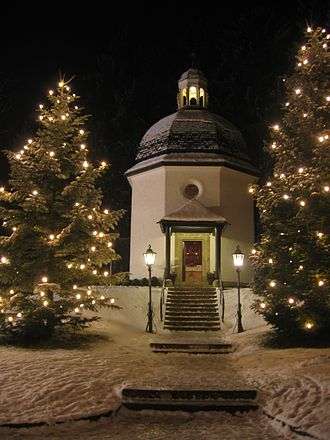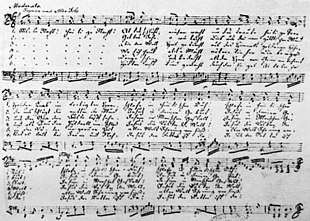Silent Night
"Silent Night" (German: "Stille Nacht, heilige Nacht") is a popular Christmas carol, composed in 1818 by Franz Xaver Gruber to lyrics by Joseph Mohr in the small town of Oberndorf bei Salzburg, Austria.[1] It was declared an intangible cultural heritage by UNESCO in 2011.[2] The song has been recorded by many singers across many music genres. The version sung by Bing Crosby in 1935 is the fourth best-selling single of all-time.
| Silent Night | |
|---|---|
| Christmas carol | |
 Silent-Night-Chapel in Oberndorf, Austria, stands on the site where the song was first performed | |
| Native name | Stille Nacht, heilige Nacht |
| Full title | Silent Night, Holy Night |
| Text | Joseph Mohr |
| Language | German |
| Melody | Franz Xaver Gruber |
| Performed | 24 December 1818 |
| Published | 1833 |
History
"Stille Nacht" was first performed on Christmas Eve 1818 at St Nicholas parish church in Oberndorf, a village in the Austrian Empire on the Salzach river in present-day Austria.[1] A young priest, Father Joseph Mohr, had come to Oberndorf the year before. He had written the lyrics of the song "Stille Nacht" in 1816 at Mariapfarr, the hometown of his father in the Salzburg Lungau region, where Joseph had worked as a co-adjutor.[3]
The melody was composed by Franz Xaver Gruber, schoolmaster and organist in the nearby village of Arnsdorf. Before Christmas Eve, Mohr brought the words to Gruber and asked him to compose a melody and guitar accompaniment for the Christmas Eve mass, after river flooding had damaged the church organ.[1][4] The church was eventually destroyed by repeated flooding and replaced with the Silent-Night-Chapel. It is unknown what inspired Mohr to write the lyrics, or what prompted him to create a new carol.[3]
According to Gruber, Karl Mauracher, an organ builder who serviced the instrument at the Obendorf church, was enamoured with the song, and took the composition home with him to the Zillertal.[5] From there, two travelling families of folk singers, the Strassers and the Rainers, included the tune in their shows. The Rainers were already singing it around Christmas 1819, and once performed it for an audience that included Franz I of Austria and Alexander I of Russia, as well as making the first performance of the song in the U.S., in New York City in 1839.[1] By the 1840s the song was well known in Lower Saxony and was reported to be a favourite of Frederick William IV of Prussia. During this period, the melody changed slightly to become the version that is commonly played today.[3][5]
Over the years, because the original manuscript had been lost, Mohr's name was forgotten and although Gruber was known to be the composer, many people assumed the melody was composed by a famous composer, and it was variously attributed to Haydn, Mozart, or Beethoven.[3] However, a manuscript was discovered in 1995 in Mohr's handwriting and dated by researchers as c. 1820. It states that Mohr wrote the words in 1816 when he was assigned to a pilgrim church in Mariapfarr, Austria, and shows that the music was composed by Gruber in 1818. This is the earliest manuscript that exists and the only one in Mohr's handwriting.[6]
The first edition was published by Friese in 1833 in a collection of Four Genuine Tyrolean Songs, with the following musical text:[7]
.jpg)
The contemporary version, as in the choral example below, is:
Translations
In 1859, the Episcopal priest John Freeman Young, then serving at Trinity Church, New York City, wrote and published the English translation that is most frequently sung today, translated from three of Mohr's original six verses.[8] The version of the melody that is generally used today is a slow, meditative lullaby or pastorale, differing slightly (particularly in the final strain) from Gruber's original, which was a "moderato" tune in 6
8 time and siciliana rhythm.[9][10] Today, the lyrics and melody are in the public domain, although newer translations usually are not.
In 1998 the Silent Night Museum in Salzburg commissioned a new English translation by Bettina Klein of Mohr's German lyrics. Whenever possible, (and mostly), Klein leaves the Young translation unchanged, but occasionally Klein (and Mohr) varies markedly. For example, Nur das traute hochheilige Paar, Holder Knabe im lockigen Haar is translated by Young: "Round yon Virgin mother and child, Holy infant so tender and mild" whereas Klein rewords it: "Round yon godly tender pair, Holy infant with curly hair", a translation closer to the original.[11]
The carol has been translated into about 140 languages.[12]
Lyrics

German lyrics[13] Young's English lyrics[14] Stille Nacht, heilige Nacht,
Alles schläft; einsam wacht
Nur das traute hochheilige Paar.
Holder Knabe im lockigen Haar,
Schlaf in himmlischer Ruh!
Schlaf in himmlischer Ruh!
Stille Nacht, heilige Nacht,
Hirten erst kundgemacht
Durch der Engel Halleluja,
Tönt es laut von fern und nah:
Christ, der Retter ist da!
Christ, der Retter ist da!
Stille Nacht, heilige Nacht,
Gottes Sohn, o wie lacht
Lieb' aus deinem göttlichen Mund,
Da uns schlägt die rettende Stund'.
Christ, in deiner Geburt!
Christ, in deiner Geburt!Silent night! Holy night!
All is calm, all is bright
Round yon virgin mother and child!
Holy infant, so tender and mild,
Sleep in heavenly peace!
Sleep in heavenly peace!
Silent night! Holy night!
Shepherds quake at the sight!
Glories stream from heaven afar,
Heavenly hosts sing Alleluia!
Christ the Saviour is born!
Christ the Saviour is born!
Silent night! Holy night!
Son of God, love's pure light
Radiant beams from thy holy face
With the dawn of redeeming grace,
Jesus, Lord, at thy birth!
Jesus, Lord, at thy birth!
Musical settings
Max Reger quotes the tune in the Christmas section of his organ pieces Sieben Stücke, Op. 145.
Alfred Schnittke composed an arrangement of "Stille Nacht" for violin and piano in 1978, as a holiday greeting for violinist Gidon Kremer. Due to its dissonant and nightmarish character, the miniature caused a scandal in Austria.[15][16]
In film
Several theatrical and television films depict how the song was ostensibly written. Most of them however are based on a spurious legend about the organ breaking down at the church in Oberndorf, which appeared in a fictional story published in the U.S. in the 1930s.[4]
- The Legend of Silent Night (1968) TV film directed by Daniel Mann
- Silent Night, Holy Night (1976) animated short film by Hanna-Barbera.[17]
- Silent Mouse (1988) television special directed and produced by Robin Crichton and narrated by Lynn Redgrave.[18]
- Buster & Chauncey's Silent Night (1998) direct-to-video animated featurette[19]
- Silent Night (2012) directed by Christian Vuissa[20]
- The First Silent Night (2014), documentary narrated by Simon Callow[21]
References
- Daley, Jason (17 December 2018). "It's the Bicentennial of 'Silent Night': The classic Christmas tune was first composed as a poem, and it was set to music for the first time in the winter of 1818". Smithsonian.com. Smithsonian Institution. Retrieved 19 December 2018.
- "Österreichische UNESCO-Kommission – Nationalagentur für das Immaterielle Kulturerbe – Austrian Inventory". Retrieved 25 December 2014.
- Egan, Bill (December 1999). "Silent Night, Holy Night". Soundscapes. University of Groningen. 2. ISSN 1567-7745. Archived from the original on 16 December 2017. Retrieved 22 December 2017.
- "Christmas carols". BBC. 4 August 2009. Archived from the original on 22 May 2009. Retrieved 6 December 2011.
- "Spreading of the Song Locally". Silent Night Association. Archived from the original on 17 December 2017. Retrieved 22 December 2017.
- "Origin of the Song". Silent Night Association. Archived from the original on 15 December 2017. Retrieved 22 December 2017.
- "Silent Night" revisited Archived 27 August 2016 at the Wayback Machine by Norbert Müllemann, G. Henle Verlag, 24 December 2012
- Underwood, Byron Edward, "Bishop John Freeman Young, Translator of 'Stille Nacht'", The Hymn, v. 8, no. 4, October 1957, pp. 123–132.
- Meredith Ellis Little (2001). Siciliana Archived 19 April 2016 at the Wayback Machine. Grove Music Online. ISBN 978-1561592630.
- Gerlinde Haid (1994). Siciliano als Typus weihnachtlicher Volksmusik. 175 Jahre "Stille Nacht! Heilige Nacht!" (in German), p.135–146. Salzburg.
- https://silent-night-museum.org/sounds/lyrics.htm Archived 15 December 2018 at the Wayback Machine Silent Night Museum 1998 translation]
- Ronald M. Clancy, William E. Studwell. Best-Loved Christmas Carols. Christmas Classics Ltd, 2000.
- Evangelisches Gesangbuch, hymn no. 46 Archived 14 December 2017 at the Wayback Machine; Gotteslob, hymn no. 249 Archived 14 December 2017 at the Wayback Machine (was 145)
- Young, John Freeman (1887). Great hymns of the church. Princeton Theological Seminary Library. New York : James Pott & Co.
- Guerrieri, Matthew (20 December 2014). "With 'Stille Nacht,' Schnittke couched protest in tradition". The Boston Globe. Archived from the original on 25 December 2017. Retrieved 24 December 2017.
- Ross, Alex (28 September 1992). "Connoisseur of Chaos: Schnittke". The New Republic. Archived from the original on 29 June 2017. Retrieved 24 December 2017 – via The Rest Is Noise.
- "Silent Night, Holy Night (TV Movie 1976)". IMDb. 27 December 2008. Archived from the original on 10 February 2017. Retrieved 17 February 2017.
- "Silent Mouse (1988)". Turner Classic Movies. Archived from the original on 8 December 2015. Retrieved 29 November 2015.
- "Buster and Chauncey's Silent Night". Turner Classic Movies. Archived from the original on 23 November 2016. Retrieved 23 November 2016.
- "Silent Night | Movieguide | Movie Reviews for Christians". Movieguide. Archived from the original on 10 September 2017. Retrieved 17 February 2017.
- First Silent Night, The Archived 25 December 2014 at the Wayback Machine, production details
External links
| Wikisource has original text related to this article: |
| German Wikisource has original text related to this article: |

- Song of peace “Silent Night” as a message of peace
- Translation of all six verses of the German original
- Free arrangements for piano and voice from Cantorion.org
- Silent Night Chapel, origin of song
- Schnittke's version on YouTube